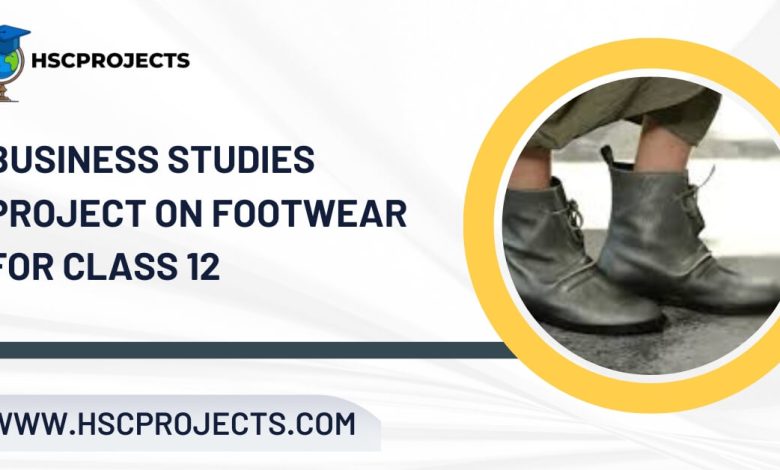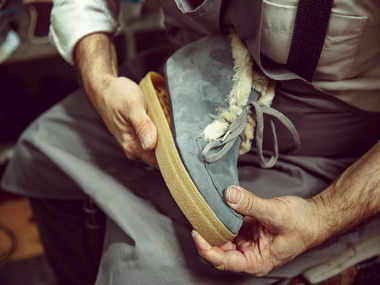
Business Studies project on footwear for class 12
Aknowledgment
“I’d want to express my sincere gratitude to everyone who helped me during the process of doing my Business Studies project on the footwear sector.
First and foremost, I want to express my sincere gratitude to my business studies teacher for mentoring me and offering insightful advice that has improved my project.
During the project’s research and preparation phase, I appreciate my family and friends’ continual support and understanding.
I want to acknowledge the useful information and statistics that have been provided by numerous footwear companies and industry experts, whose willingness to share their knowledge has been important in determining the project’s overall structure.
I also want to express my gratitude to the library personnel for helping me find relevant books and academic resources.
Your contributions have been invaluable, and I am genuinely grateful for each and every one of you. Thank you for your assistance, which has been essential to the successful completion of this project on footwear.
“[Your Name]”
Introduction:
The footwear business is crucial to the global economy because it caters to the fundamental need for footwear while also keeping up with consumer preferences and ever-evolving fashion trends. An business worth billions of dollars, footwear includes athletic shoes, casual shoes, formal shoes, sandals, boots, and more. The footwear business serves a wide range of consumers worldwide, offering anything from protective and useful footwear for specific activities to fashionable alternatives for everyday wear.
Footwear has played a crucial role in human civilization for countless generations, evolving from crude protective coverings to intricate and stylish designs that reflect different cultural influences and personal tastes. The industry now emphasises aesthetics, comfort, and innovation in addition to utility and functionality. Consumers’ demands for footwear that complements their own styles while still being comfortable and durable increase as consumer life styles continue to change.
Intense competition and ongoing innovation are characteristics of the footwear business. Established brands compete for market share with up-and-coming players and niche designers, fostering a lively and dynamic market environment. Technology advancements and globalisation have further accelerated the industry’s development by enabling footwear companies to connect with customers globally through e-commerce and online platforms.
We will examine a number of aspects of the footwear market in this project, such as market dynamics, key players, production procedures, distribution channels, marketing strategies, and consumer behaviour. We want to understand the variables that contribute to this industry’s success, the challenges it faces, and the opportunities that lie ahead by obtaining insight into how it is always changing.
We will shed light on the significance of the footwear industry in the context of modern business and its effects on consumers, the economy, and the environment via comprehensive research and analysis. With the help of this project, we will be able to understand the complex interplay between fashion, technology, marketing, and consumer preferences that fuels this vibrant sector.
Market Overview
The worldwide consumer products business includes a sizable and vibrant segment known as the footwear market. It includes a wide range of goods catered to various consumer needs and preferences. Let’s explore the market overview of the footwear sector:
- Market Size and Development:The size of the footwear market is enormous and is measured in billions of dollars. Population expansion, growing disposable incomes, shifting fashion trends, and increased awareness of health and fitness are some of the causes that contribute to its ongoing rise. Due to urbanisation and rising consumer spending power, developing regions like Asia-Pacific and Latin America have emerged as major contributors to the market’s expansion.
- Worldwide Footprint:The footwear industry operates on a worldwide scale, with goods produced and sent to almost every corner of the globe. China, India, Vietnam, Indonesia, and Italy are notable manufacturing centres where a significant amount of the world’s footwear is produced. The United States, China, India, Japan, and European nations are among the top consumer markets for footwear.
- Merchandise Segmentation:Based on the kind of shoes, the footwear market is segmented into numerous categories. Athletic footwear (sports shoes and sneakers), casual footwear (canvas shoes, loafers and sandals), formal footwear (dress shoes and business shoes) and footwear specifically designed for activities like jogging, dancing and trekking are all included in these segments.
- Customer Preferences:Consumer preferences are key in influencing the footwear market. Consumers want trendy and contemporary designs that complement their own style since fashion trends are continuously changing. Additionally, consumers who are environmentally sensitive are placing a greater emphasis on sustainable and eco-friendly footwear solutions.
- keen players:The footwear market is very competitive, with many established and up-and-coming players contending for market share. Niké, Adidas, Puma, Rêbok, New Balance, Skechers, Clarks, Crocs, and Vans are a some of the well-known international brands. To preserve their competitive edge, these firms heavily invest in product innovation, marketing, and celebrity endorsements.
- Publication Channels:Distributors of footwear include brick-and-mortar retailers, department stores, specialty shoe retailers, online merchants, and company-owned brand stores. In recent years, e-commerce has seen rapid expansion, giving consumers convenient purchasing alternatives and extending the reach of footwear manufacturers to a wider audience.
- The effects of technologyThe advancement of technology has been very important to the footwear sector. Technology has enabled firms to provide innovative goods that cater to consumers’ changing needs and preferences, from advanced manufacturing processes like 3D printing to smart footwear including fitness monitoring sensors.
Challenges and Possibilities:
- Raw Material Costs: Variations in the price of raw materials, particularly leather, rubber, and synthetic textiles, may affect the profit margins of footwear manufacturers. These materials’ volatile prices might make production planning and cost estimation difficult.
- Intense Competition: There is fierce competition among brands for market share in the footwear sector. A competitive environment created by established global companies and emerging local players need ongoing innovation and marketing efforts.
- Fashion & Trends: The footwear industry’s fashion trends change quickly, making it difficult for manufacturers and retailers to stay on top of consumer preferences. Failure to foresee or adapt to shifting trends may lead to excessive inventory or missed sales opportunities.
- Environmental concerns and sustainability: Consumers are becoming more and more aware of the effects that the things they buy have on the environment. Footwear companies are under pressure to embrace environmentally friendly and sustainable practises, such as recycling materials and lowering carbon footprints.Due to the worldwide nature of the footwear business, complex supply chains are a result. It may be difficult to manage suppliers, logistics, and distribution networks effectively, especially when working with several international partners.
- Counterfeit Products: The sector faces a serious challenge from counterfeit footwear. These counterfeit goods damage brand reputation as well as revenue and potential consumer safety concerns.

Opportunities:
- E-Commerce Development: The growth of e-commerce offers enormous opportunities for footwear businesses to reach a wider audience and boost sales. Online platforms provide better direct-to-consumer sales channels, personalised marketing, and customer engagement.
- Customization and personalization: Consumers are appreciating things that are made specifically to suit their preferences. Footwear companies may use technology to provide customisation possibilities, enabling customers to design their shoes in accordance with their preferences for style, size, and comfort.
- Technology and innovation: Advances in technology, such as 3D printing, smart footwear, and sustainable materials, provide opportunities for product differentiation and satisfying changing consumer demands.
- Increasing Your Market Reach: Emerging economies provide untapped opportunities for footwear companies to increase their market reach. A burgeoning consumer base is created in these regions by rising disposable incomes and urbanisation.
- Collaborations and Endorsements: Obtaining endorsements and brand partnerships from celebrities, athletes, or fashion influencers may greatly increase a business’s exposure and credibility.
- Emphasis on Sustainability: Brands may stand out in the market by focusing on sustainability in both product design and production procedures. This can draw in environmentally sensitive customers.
- Omni-Channel Approach: By integrating physical stores and online platforms, an omni-channel retail strategy may provide customers a seamless shopping experience and boost brand loyalty.
- Conclusion: Despite the many challenges the footwear industry faces, there are several opportunities for businesses to thrive by embracing innovation, sustainability, and technology, as well as by adjusting to shifting consumer preferences and market dynamics. Footwear businesses may be set up for long-term success and development by handling these challenges successfully and seizing opportunities.
Conclusion:
The footwear business is a dynamic and thriving sector that is essential to satisfying the various needs and preferences of consumers throughout the globe. We have explored numerous aspects of the footwear business throughout this project, from its inception as a fundamental need to its development into a vibrant market driven by fashion, technology, and consumer lifestyles.
The market overview highlighted the size of the footwear sector, which has a considerable impact on the economy and a worldwide reach. We have seen the market’s ongoing rise, which is driven by factors such as population expansion, growing disposable incomes, and shifting fashion trends.
Although the sector is expanding, it nevertheless faces challenges that call for cautious navigation. The main challenges faced by footwear companies are the instability of raw material prices, intense competition, and the need to balance fashion with sustainability. Taking on these challenges will need a strategic strategy that includes innovative design, environmentally friendly practises, and effective supply chain management.
On the other hand, we identified a number of business opportunities for the footwear sector. Enhancing customer engagement and broadening market reach may be accomplished through embracing e-commerce, personalization, and technological advancements. Additionally, concentrating on emerging markets and implementing sustainable practises provide untapped potential for development and brand differentiation.
Future success for the footwear industry will depend on its capacity to meet consumer demands, be flexible in a market that is continually changing, and align with sustainable and environmentally friendly practises. Companies that embrace these advancements and adjust to shifting consumer preferences will be well-positioned to thrive in the competitive landscape as technology continues to drive innovation.
We have gained insights into the complexities of the footwear business during this project, from the production processes and distribution channels to the influence of fashion and technology on consumer behaviour. Consumers are actively seeking footwear that not only reflects their own style but also adheres to their values, therefore the industry must adapt to these changing needs.
Finally, it should be noted that the footwear business encompasses more than simply practical footwear; it is a dynamic, multifaceted ecosystem that combines art, technology, and consumer desires. Understanding the difficulties and opportunities presented by this market will enable businesses to steer clear of failure, enriching consumers’ lives and adding to the always changing landscape of fashion and lifestyle.
Certificate:
[Logo of Your School/Institution]Date: [Present Day]
Dear [Name of the Teacher],
I’m excited to present my finished project for Class 12 on “Footwear Industry: Trends, Challenges, and Business Opportunities.” This project has been enlightening and interesting, enabling me to explore the dynamic world of the footwear industry and its many facets.
I immersed myself in the interesting history of footwear and its historical evolution throughout this project. Footwear’s journey from humble beginnings to become a major force in the world of fashion has been both fascinating and motivating. I conducted research on the numerous types of footwear, their cultural significance, and their evolution in response to changing consumer preferences.
The project also included a detailed examination of the current trends and market dynamics in the footwear sector. I looked at the effects of technology, fashion, and sustainability on the footwear market, emphasising how important it is to remain relevant and environmentally responsible in the current business climate.
Understanding the difficulties the footwear business faces was a key component of my research. Rising manufacturing costs, supply chain complexity, and market competition have all presented substantial challenges for businesses. I also explored the rising concern over the environmental effects of the footwear business and the efforts being made towards sustainable practises.
I got the chance to interview professionals in the footwear sector to get useful insights. Their expertise and experience provided important insight into the inner workings of the industry, the strategies used to overcome obstacles, and the potential for development and innovation.
Additionally, I polled my friends and family members to get their opinions on their shopping preferences and footwear preferences. The survey results provided insightful information that was helpful in understanding the needs and expectations of potential customers.
I really appreciate the consistent encouragement and guidance provided by my subject teacher, [Teacher’s Name], during this project. Their expertise and constructive criticism helped to shape my research and analysis, and I am appreciative of their unwavering support.
In addition, I would want to express my gratitude to my parents and guardians for their unwavering support and encouragement during this project. Their confidence in my abilities encouraged me to work hard and aim for excellence in my research and presentation.
I also like to thank my classmates and friends for participating in insightful conversations and offering insightful feedback. Their comments have helped me to better understand the subject matter.
Furthermore, I like that a variety of resources, such as books, articles, online databases, and industry reports, are readily available. These resources were invaluable for gathering trustworthy data and giving a thorough overview of the footwear sector.
This project’s completion has been an enriching experience that has deepened my interest in entrepreneurship and business management. I’m eager to use the knowledge and insights I’ve gained from this project in my future academic endeavours and professional goals.
It is a privilege to get this Certificate of Appreciation, and I am really appreciative for the chance to work on the “Footwear Industry: Trends, Challenges, and Business Opportunities” project. I hope that the research presented in this project contributes to a better understanding of the challenges facing the footwear industry and motivates aspiring entrepreneurs to successfully navigate this dynamic business environment.
I want to express my heartfelt gratitude to everyone who helped the project titled “Footwear Industry: Trends, Challenges, and Business Opportunities” be completed successfully. Your support and assistance have been priceless, and I really appreciate your faith in my abilities.
Sincerely,
(“Your Name”)
In order to download the PDF, You must follow on Youtube. Once done, Click on Submit
Follow On YoutubeSubscribed? Click on Confirm
Download Business Studies project on footwear for class 12 PDF






